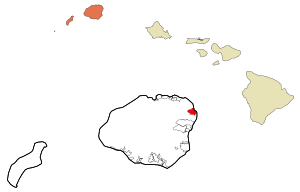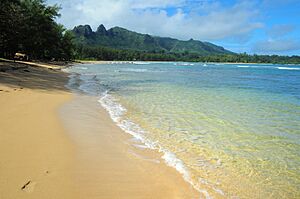Anahola, Hawaii facts for kids
Quick facts for kids
Anahola, Hawaii
|
|
|---|---|

Location in Kauai County and the state of Hawaii
|
|
| Country | United States |
| State | Hawaii |
| County | Kauai |
| Area | |
| • Total | 4.07 sq mi (10.54 km2) |
| • Land | 3.69 sq mi (9.54 km2) |
| • Water | 0.39 sq mi (1.00 km2) |
| Elevation | 30 ft (9 m) |
| Population
(2020)
|
|
| • Total | 2,243 |
| • Density | 608.68/sq mi (235.04/km2) |
| Time zone | UTC-10 (Hawaii-Aleutian) |
| ZIP code |
96703
|
| Area code(s) | 808 |
| FIPS code | 15-02200 |
| GNIS feature ID | 0358587 |
Anahola is a small community in Hawaiʻi, United States. Its name means "deadly winds" in the Hawaiian language. It is located on the island of Kauaʻi. In 2020, about 2,243 people lived there.
History of Anahola
Anahola has an interesting history. Long ago, King Kamehameha I united all the Hawaiian islands. But Kauaʻi, where Anahola is, was the last island to join his kingdom. Its ruler, Kaumualii, bravely resisted Kamehameha for many years.
Anahola is also famous for an old surfing spot. It was called Ka-nahā-wale. This name means "easily broken," perhaps describing the waves there!
Geography of Anahola
Anahola is located on the northeast coast of Kauai. It is about 9 meters (30 feet) above sea level. The community covers an area of about 10.4 square kilometers (4.0 square miles). Most of this area is land, but about 1 square kilometer (0.39 square miles) is water.
Anahola is right next to Anahola Bay. This bay is part of the Pacific Ocean. The community is about 21 kilometers (13 miles) north of Lihue. It is also about 16 kilometers (10 miles) southeast of Kilauea.
People of Anahola
| Historical population | |||
|---|---|---|---|
| Census | Pop. | %± | |
| 2020 | 2,243 | — | |
| U.S. Decennial Census | |||
In 2000, there were 1,932 people living in Anahola. They lived in 549 households. About 36% of these households had children under 18. The average household had about 3.5 people.
The people living in Anahola came from many different backgrounds. Many residents were of Pacific Islander descent. There were also people who identified as White, Asian, and other races. About 29% of the people were from two or more racial backgrounds.
The population was spread out by age. About 31% of the people were under 18 years old. The median age was 32 years. This means half the people were younger than 32, and half were older.
See Also
 In Spanish: Anahola para niños
In Spanish: Anahola para niños


